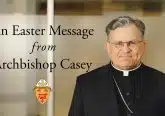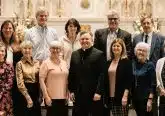Christ at the Center
September 9, 2011
Archdiocesan initiative aims to keep Christ at center of our lives
By Eileen Connelly, OSU
ARCHDIOCESE — With support from Archbishop Dennis M. Schnurr, the offices of the archdiocese have responded to the call for a new evangelization by developing the initiative Christ at the Center.
It is “not a program with an end date, but a comprehensive, continuing process of more deeply engaging all of us to keep Christ’s living presence at the heart of all we do so that our faith becomes a comprehensive way of life,” the archbishop writes in this month’s issue of The Catholic Telegraph.
Family faith and the Eucharist are the centerpieces of the initiative, which has been adopted by a number of archdiocesan offices. Christ at the Center is the result of several years of development by an interdisciplinary group of archdiocesan staff members and the Archdiocese of Cincinnati Worship Commission. It involves two efforts that have and will continue to progress both collaboratively and independently of each other — nurturing eucharistic communities and continuing to build family faith.
According to Sean Reynolds, director of archdiocesan Office of Youth and Young Adult ministry, work on the initiative began in 2008, after staff members participated in a study day with Leif Kehrwald, a national expert on family ministry and faith formation and current project coordinator on the Lifelong Faith Formation Team at the Center for Ministry Development. At the same time, the archdiocesan Workshop Commission was beginning to examine ways to introduce the third edition of the Roman Missal.
The work of the two groups converged, said Karen Kane, director of the archdiocesan Worship Office, as they recognized the need collaborate to more effectively address various issues and concerns. For example, noted Reynolds, research such as that conducted by the National Study of Youth and Religion, indicates that the declines both in lived faith and Sunday Mass attendance are directly related to whether and how parents form the faith of their children.
“The faith of young people is intimately connected to the faith of their parents. Nothing else even comes close,” Reynolds said. “This is nothing new, though. The church has consistently taught that parents are the primary formers of their children’s faith. The research indicates that Catholic schools and youth ministry programs won’t get much traction in the absence of parental involvement.”
“We know from the research that unless their parents model their faith at home, children will probably not grow into their faith as adults,” he added. “Unless families live their faith at home, there will be no people in the pews.”
Therein lies the relationship between nurturing family faith and building eucharistic community, noted Kane. “As Catholics, the Eucharist is the source and summit of our lives; it is at the heart of who we are and what we do,” she said. “The faith of families is nourished and fed at Mass. It’s where all of us give thanks and praise to God and gain the strength to live our lives as God has called us.”
However, she added, “families won’t find their way to Mass unless their faith is nourished. We have to look at how we can engage them more their faith lives in a way that will bring them to Mass and help them make the connection between their lives and the liturgy.”
Kane and her fellow office directors agree that many parents have difficulty passing on the faith to their children because their own faith lacks sufficient formation and they simply don’t know how. In addition, for many families, faith and religion have been driven to the margins of their lives by other commitments, involvements and priorities.
The Christ at the Center initiative has been focused on addressing these issues with collaborative, interdisplinary efforts that have included developing liturgical catechetical materials to assist parishes in providing full parish catechesis, and working with parish staffs and communities to empower parents to initiate and raise their children in the knowledge of their faith, prayer, liturgy, morality, Catholic social teaching, community life and the missionary activity of the church.
One example is a DVD developed by the Youth and Young Adult Ministry and Worship offices geared toward preparing young people for the new missal. In addition, said Kane, her office has been working closely with the archdiocesan Family and Respect Life Office, under the direction of Colleen Gerke, on sacramental preparation programs. Gerke has also been working with Ken Gleason, director of the archdiocesan Office of Evangelization and Catechesis on a variety of projects that will emphasize a more conscious effort on the part of parents to foster faith within their families. This includes reintroducing the program “Great Expectations: Coaching Parents to Form Their Child in Faith.” And, in September 2012 a symposium based on “A Family Perspective in Church and Society,” the U.S. bishops’ document on family ministry, is planned in Dayton.
Regarding the initiative, Gerke said, “What is new for us is that when we respond to a need, we look at not only what our office can provide, but what the archdiocesan offices can jointly provide to parishes. It means responding to the needs of the church with a new depth and breath that can only be accomplished when you use all the available resource of the many offices of the archdiocese working in partnership.”
“Christ at the Center is an opportunity to for us to examine how we invite people into lives of faith that trust in the Paschal mystery, that God is greater than we are and has power over sin and death,” Kane said. “It’s an opportunity to remember that we can trust in the experience of Christ we have every Sunday at Mass, find hope and strength in Him and put Him at the center of all we do.”













